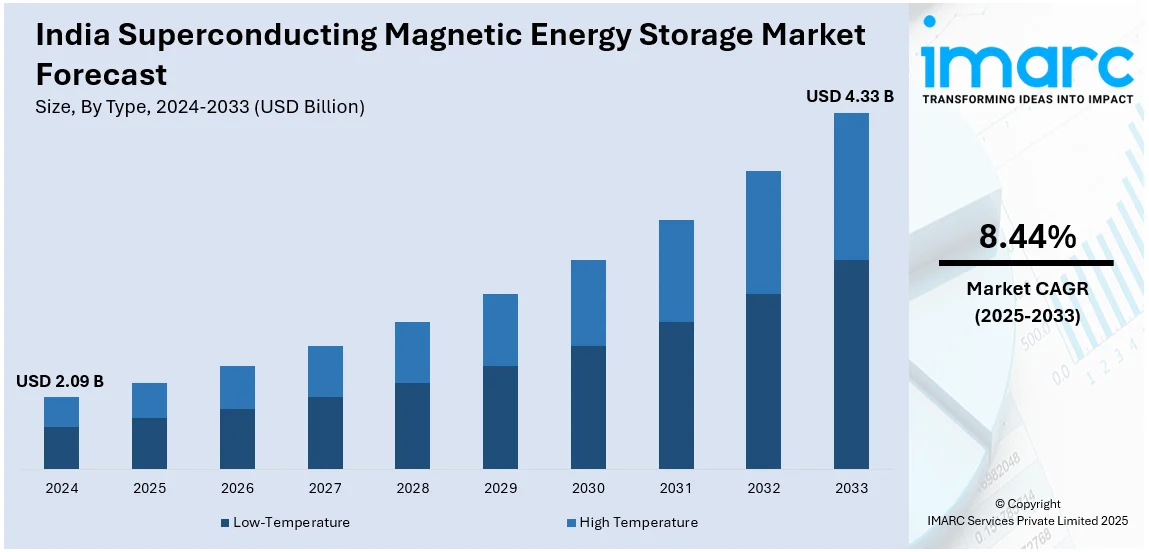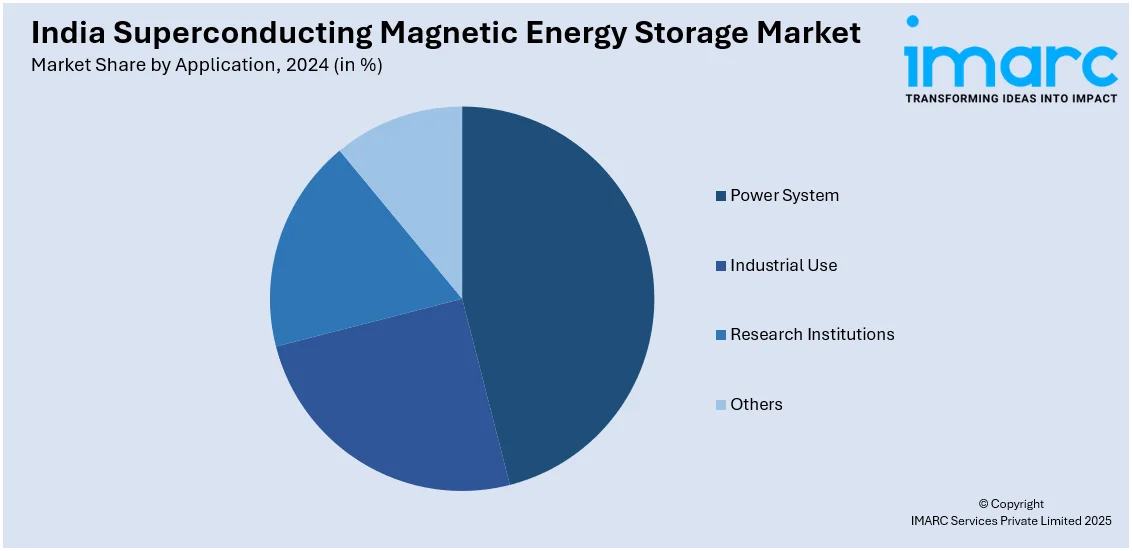
India Superconducting Magnetic Energy Storage Market Size, Share, Trends and Forecast by Type, Component, Application, and Region, 2025-2033
India Superconducting Magnetic Energy Storage Market Overview:
The India superconducting magnetic energy storage market size reached USD 2.09 Billion in 2024. Looking forward, IMARC Group expects the market to reach USD 4.33 Billion by 2033, exhibiting a growth rate (CAGR) of 8.44% during 2025-2033. The market in India is gaining attention due to increasing grid stability needs, renewable energy integration, and demand for efficient energy storage solutions. Advancements in superconducting materials, government initiatives, and rising electricity consumption are key drivers shaping market growth and adoption.
|
Report Attribute
|
Key Statistics
|
|---|---|
|
Base Year
|
2024 |
|
Forecast Years
|
2025-2033
|
|
Historical Years
|
2019-2024
|
| Market Size in 2024 | USD 2.09 Billion |
| Market Forecast in 2033 | USD 4.33 Billion |
| Market Growth Rate 2025-2033 | 8.44% |
India Superconducting Magnetic Energy Storage Market Trends:
Rising Demand for Grid Stability and Energy Efficiency
Advanced energy storage technologies are becoming increasingly necessary in India, driven by the country's rapidly growing urbanization and industrialization, which is driving up electricity demand. The technology known as Superconducting Magnetic Energy Storage (SMES) is attracting interest because it can lower transmission losses, increase grid dependability, and provide an instantaneous power source. Concurrent with this, the integration of solar and wind power into the grid poses issues pertaining to supply fluctuations as the nation grows its renewable energy infrastructure. SMES ensures smooth and continuous power distribution by stabilizing voltage and frequency fluctuations. The National Smart Grid Mission (NSGM), which supports advanced energy storage research and pilot projects, is a significant advancement in this field. SMES are being investigated to provide a steady, fluctuation-free power supply in specific high-load industries, like data centers and semiconductor production, avoiding operational disturbances. India's aerospace and defense industries are also assessing SMES for uses requiring quick discharge and high-density energy storage. The adoption of SMEs is anticipated to increase with government-supported programs and research partnerships, assisting India in achieving its objectives for sustainability and energy efficiency while maintaining grid stability in a changing power environment.

To get more information on this market, Request Sample
Advancements in Superconducting Materials and Cost Reduction
The development of high-temperature superconductors (HTS) is revolutionizing the SMES market in India by making energy storage systems more cost-effective and practical. Earlier superconducting materials required extremely low temperatures for operation, increasing infrastructure costs. However, advancements in HTS materials allow SMES systems to function at higher temperatures, reducing reliance on expensive cooling mechanisms. This progress enhances the feasibility of deploying SMES in diverse applications, including industrial power management and renewable energy integration. A significant milestone in this area is a joint research project by IIT Madras and leading energy firms, focusing on integrating superconducting storage solutions with microgrids for improved efficiency. Another development is the exploration of compact and modular SMES units, which are designed to be more scalable and accessible for commercial use. Additionally, India's National Energy Storage Mission is pushing for research funding and policy incentives to accelerate the adoption of advanced storage technologies. These technological improvements, along with declining costs, are positioning SMES as a highly efficient and reliable alternative to traditional battery storage, ensuring a more sustainable and resilient power sector in India.
India Superconducting Magnetic Energy Storage Market Segmentation:
IMARC Group provides an analysis of the key trends in each segment of the market, along with forecasts at the region/country level for 2025-2033. Our report has categorized the market based on type, component, and application.
Type Insights:
- Low-Temperature
- High Temperature
The report has provided a detailed breakup and analysis of the market based on the type. This includes low-temperature and high temperature.
Component Insights:
- Superconducting Coil
- Power Conditioning System (PCS)
- Cryogenics System
- Control and Monitoring System
The report has provided a detailed breakup and analysis of the market based on the component. This includes superconducting coil, power conditioning system (pcs), cryogenics system, and control and monitoring system.
Application Insights:

- Power System
- Industrial Use
- Research Institutions
- Others
A detailed breakup and analysis of the market based on the application have also been provided in the report. This includes power system, industrial use, research institutions, and others.
Region Insights:
- North India
- South India
- East India
- West India
The report has also provided a comprehensive analysis of all the major regional markets, which include North India, South India, East India, and West India.
Competitive Landscape:
The market research report has also provided a comprehensive analysis of the competitive landscape. Competitive analysis such as market structure, key player positioning, top winning strategies, competitive dashboard, and company evaluation quadrant has been covered in the report. Also, detailed profiles of all major companies have been provided.
India Superconducting Magnetic Energy Storage Market Report Coverage:
| Report Features | Details |
|---|---|
| Base Year of the Analysis | 2024 |
| Historical Period | 2019-2024 |
| Forecast Period | 2025-2033 |
| Units | Billion USD |
| Scope of the Report |
Exploration of Historical Trends and Market Outlook, Industry Catalysts and Challenges, Segment-Wise Historical and Future Market Assessment:
|
| Types Covered | Low-Temperature, High Temperature |
| Components Covered | Superconducting Coil, Power Conditioning System (PCS), Cryogenics System, Control and Monitoring System |
| Applications Covered | Power System, Industrial Use, Research Institutions, Others |
| Regions Covered | North India, South India, East India, West India |
| Customization Scope | 10% Free Customization |
| Post-Sale Analyst Support | 10-12 Weeks |
| Delivery Format | PDF and Excel through Email (We can also provide the editable version of the report in PPT/Word format on special request) |
Key Benefits for Stakeholders:
- IMARC’s industry report offers a comprehensive quantitative analysis of various market segments, historical and current market trends, market forecasts, and dynamics of the India superconducting magnetic energy storage market from 2019-2033.
- The research report provides the latest information on the market drivers, challenges, and opportunities in the India superconducting magnetic energy storage market.
- Porter's Five Forces analysis assist stakeholders in assessing the impact of new entrants, competitive rivalry, supplier power, buyer power, and the threat of substitution. It helps stakeholders to analyze the level of competition within the India superconducting magnetic energy storage industry and its attractiveness.
- Competitive landscape allows stakeholders to understand their competitive environment and provides an insight into the current positions of key players in the market.
Key Questions Answered in This Report
The superconducting magnetic energy storage market in India was valued at USD 2.09 Billion in 2024.
The India superconducting magnetic energy storage market is projected to exhibit a CAGR of 8.44% during 2025-2033, reaching a value of USD 4.33 Billion by 2033.
Increasing energy storage needs to stabilize the power grid, integration of renewable energy, and increasing demand for electricity are major drivers. Superconducting material technology improvements, government incentives for clean energy schemes, and high-efficiency, quick-response storage needs of industries and utilities drive the adoption of SMES systems in India.
Need more help?
- Speak to our experienced analysts for insights on the current market scenarios.
- Include additional segments and countries to customize the report as per your requirement.
- Gain an unparalleled competitive advantage in your domain by understanding how to utilize the report and positively impacting your operations and revenue.
- For further assistance, please connect with our analysts.
 Request Customization
Request Customization
 Speak to an Analyst
Speak to an Analyst
 Request Brochure
Request Brochure
 Inquire Before Buying
Inquire Before Buying




.webp)




.webp)












